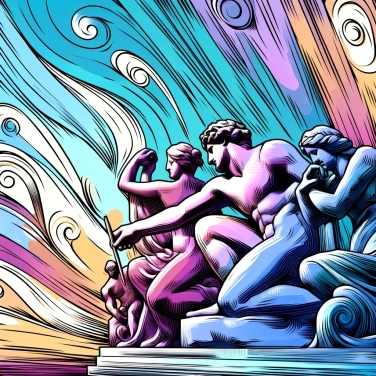Bronze casting has been used since antiquity to create durable sculptures due to its resistance to corrosion, its malleability making it easier for sculptors to work with, and its ability to preserve the fine details of the artworks.

Bronze is an alloy composed mainly of copper and tin. When mixed, these two metals create a material that is much stronger and more durable than each metal taken separately. This composition allows bronze to easily resist wear, impacts, and harsh weather conditions like rain or humidity. Unlike iron, for example, bronze does not rust. Over time, it slowly oxidizes to form a protective layer called patina, which ensures natural preservation over several centuries. This explains why so many bronze sculptures, even those thousands of years old, remain intact and visible today.
Bronze has a really practical feature, which is the remarkable fluidity it achieves when heated sufficiently. This property allows it to easily fill in all the details of a mold, even the smallest or finest. As a result, artists and craftsmen in antiquity could reproduce the same sculpture multiple times and accurately with the same mold, without too much hassle. Thanks to this, a work could have several copies, each identical and precise, without losing quality or accuracy. This is a good point for widely disseminating a valued work or creating coherent series.
Bronze, when exposed to the open air, naturally develops a superficial layer called patina. This phenomenon is simply a reaction of the bronze surface with moisture and oxygen, but far from being negative, it is precisely what makes bronze so remarkable. This fine layer protects the sculpture by allowing it to withstand corrosion and weather-related damage. Furthermore, aesthetically, the patina gives a coloration ranging from pale green to dark brown that adds a particular charm, valued since Antiquity. It’s no wonder that sculptors have always appreciated this feature that enhances their works over time.
Some ancient bronze statues are frankly impressive in their state of preservation. The Discobolus of Myron, for example, is a classic known mainly through its Roman copies, even though the original Greek no longer exists today. But works like the famous Riace Bronzes, discovered in 1972 in the Mediterranean Sea, defy time by showcasing all the qualities of bronze: detailed musculature, realistic expressions, and finesse in the hair and beard. The equestrian statue of Marcus Aurelius, displayed in Rome, also impresses with its striking realism, having survived the centuries almost intact. These ancient bronzes remain today as very concrete witnesses of the technical and artistic skills of ancient craftsmen.
The famous ancient statue 'The Charioteer of Delphi,' created around 470 BC, is one of the few Greek bronze sculptures that have been preserved in its entirety, showcasing the incredible durability of bronze over the centuries.
The greenish patina that appears on the surface of bronze sculptures over time is not just aesthetic; it represents a natural protective layer that prevents internal corrosion.
Thanks to the technique of 'lost wax' casting, mastered since ancient times, artisans were able to create precise and complex reproductions in bronze, which explains the great artistic finesse of these historical sculptures.
Although iron and bronze coexisted in history, bronze remained the preferred choice for sculptures and works of art due to its ease of casting, resistance to rust, and warm visual appeal.
Some famous bronze sculptures from Antiquity include the Poseidon (or Zeus) of Artemision, the Riace Bronzes, and the Capitoline Wolf. These works, still visible today, wonderfully showcase the exceptional resistance of bronze to corrosion and the deterioration caused by time.
Bronze is considered relatively eco-friendly because it is a durable and fully recyclable metal. Many ancient sculptures were made from recycled bronzes sourced from earlier works. Recycling bronze preserves its physical properties while reducing the environmental impact of artistic creation.
Bronze naturally develops an outer layer called patina. This patina, typically a green-blue or brownish hue, results from the oxidation of the metal when exposed to air and moisture. It serves the advantage of providing additional protection to the sculpture while adding a characteristic aesthetic appreciated by many enthusiasts and collectors.
To maintain a bronze sculpture, regularly use a soft, dry cloth to remove accumulated dust. Avoid harsh chemicals and keep it away from excessive moisture. If deeper cleaning is necessary, use very mild soapy water and dry it immediately to avoid altering the protective patina.
Bronze offers an excellent balance between fluidity, strength, and the ability to reproduce fine details during casting. Its capacity to flow easily into complex molds makes it an optimal choice for sculpting detailed pieces with delicate or precise features.

No one has answered this quiz yet, be the first!' :-)
Question 1/5